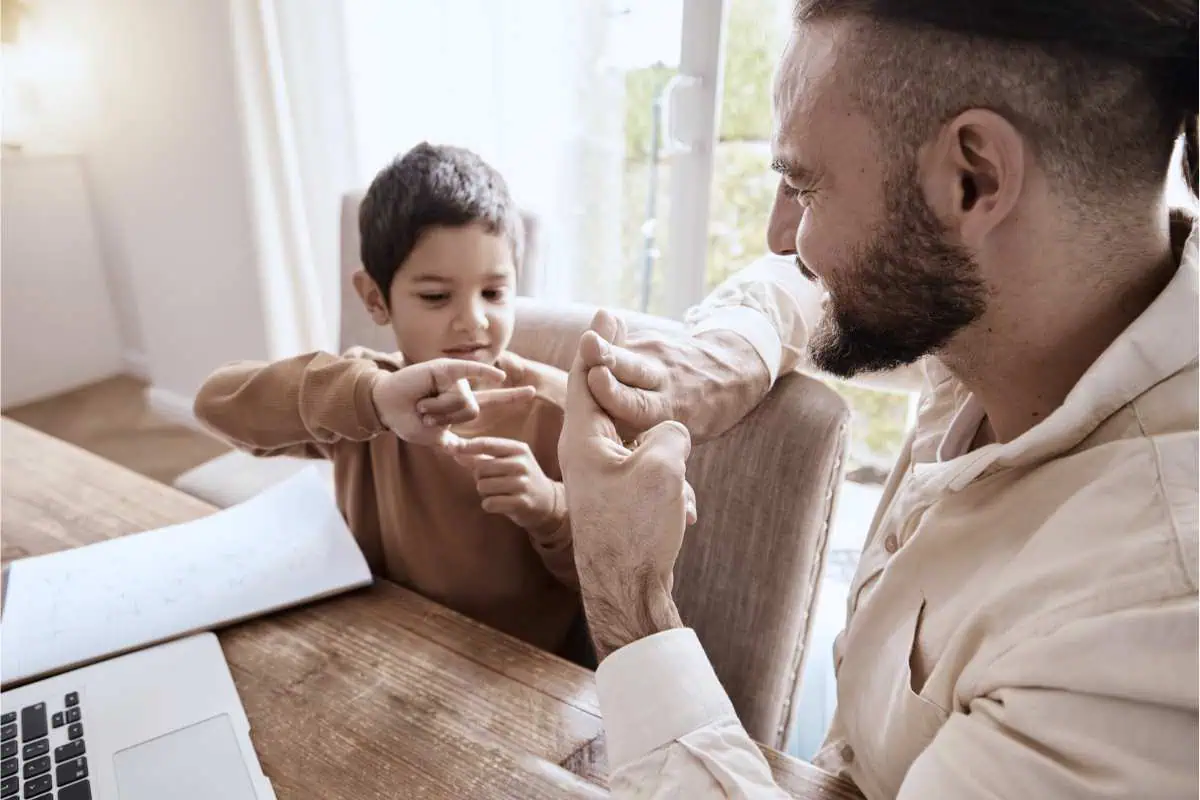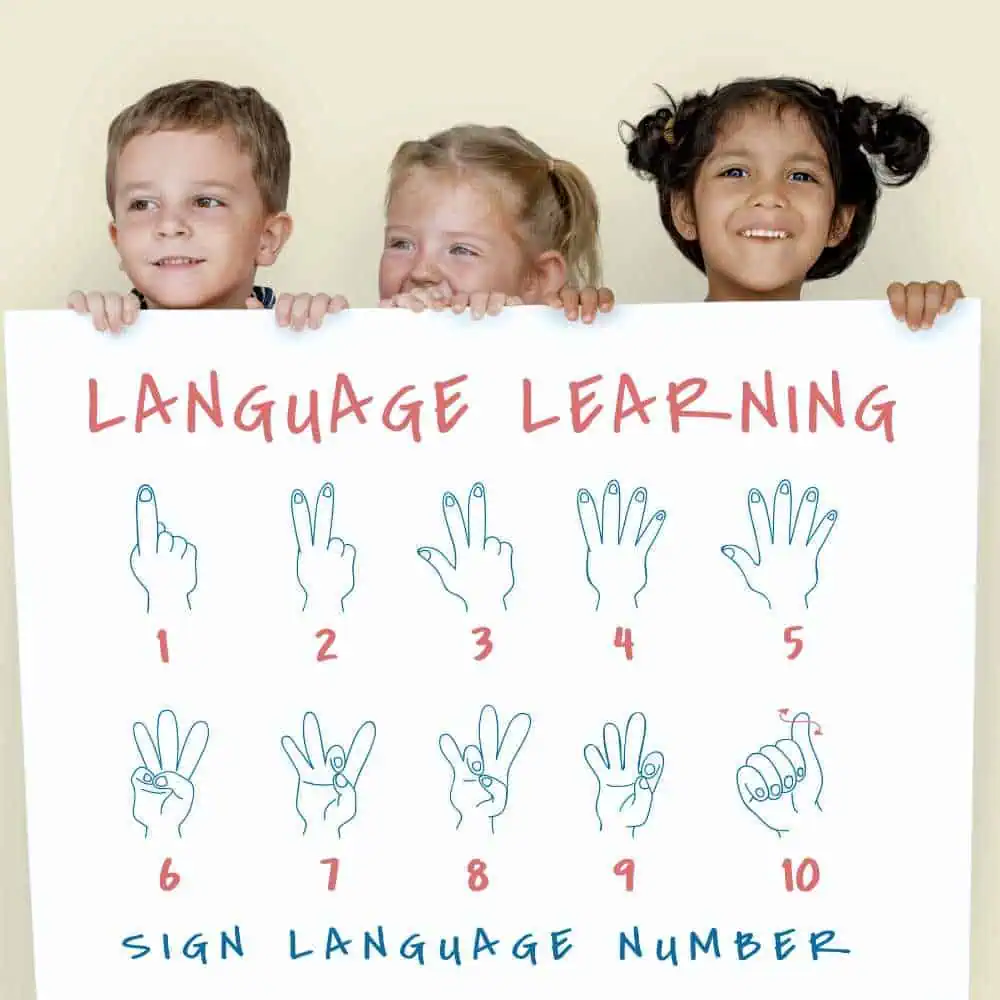How To Learn Sign Language For Kids
Learning sign language is a fantastic way for kids to communicate in a new and exciting way! If you’re wondering how to learn sign language, it’s easier than you might think, especially with fun activities and resources designed just for kids.
Start with basic signs like the alphabet and everyday words, then practice with songs, games, and stories to make learning engaging and interactive.
Whether you’re learning at home or in school, sign language is a valuable skill that helps kids connect with the Deaf community and gain a deeper understanding of communication.
A well-rounded approach uses an ASL homeschool curriculum. It effectively helps parents and children learn together.

**This post may contain affiliate links. As an Amazon Associate and a participant in other affiliate programs, I earn a commission on qualifying purchases.**
Why teach sign language?
Learning ASL improves communication and helps promote inclusivity. More colleges now view ASL as an important foreign language for education and careers.
According to the American Sign Language Teachers Association (ASLTA), “ASL is a fully developed, natural language that serves as the primary means of communication for many deaf Americans.”
Top schools like Harvard University value ASL too. Their Summer School Director says, “ASL is one of the few languages that is applicable to every major offered at Harvard.”
This shows that learning American Sign Language is more than a skill. It’s a step towards being a global citizen and understanding others.
Understanding the basics of sign language
Learning the basics of sign language means knowing the key signs for daily communication.
This includes signs for common words, phrases, and the alphabet. Kids start by mastering simple signs like those for family members, emotions, and daily activities.
Clear demonstrations and repetition are key to helping them grasp these concepts. It’s also key to teach how facial expressions and body language in sign language help convey meaning.
By focusing on these basics, children can build a strong foundation for more advanced sign language skills.
Use our free sign language alphabet worksheets to help kids practice fingerspelling and reinforce their understanding of the ASL alphabet. These worksheets are perfect for building confidence and making learning interactive and fun.

Engaging activities to make learning fun
To make learning ASL fun, incorporate engaging activities that captivate children’s interest.
Use storytelling with sign language to bring tales to life, enhancing their vocabulary and narrative skills.
Interactive games like ‘Sign and Seek,’ where kids identify objects or actions based on signs, boost their memory and recognition.
Crafts like making flashcards or sign language posters boost creativity and learning.
Role-playing, where kids use signs in different situations, builds practical skills.
These activities not only make learning enjoyable but also deepen their understanding and use of sign language.
Check out all of the best homeschool foreign language curriculum!
The role of visual aids in sign language education
Visual aids are key in teaching sign language to children.
Pictures, diagrams, and videos help kids grasp and copy the movements for each sign.
These visuals make it clearer how to use hands and faces to communicate well. Flashcards and posters remind them to practice, even outside of lessons.
Video tutorials show how to sign smoothly, helping kids remember and use signs better.
These aids make learning easier and more fun, helping kids connect deeply with sign language.
Interactive games for reinforcing sign language skills
Interactive games are a great way to boost sign language skills in a fun way.
Sign bingo lets kids match signs on their cards as they see them, helping them recognize and remember signs.
Playing charades with sign language lets kids express themselves and guess signs. This improves their understanding.
Memory games with sign language flashcards build their vocabulary and thinking skills.
Online apps and games offer quizzes and challenges that give quick feedback and make practicing fun.
These games make learning sign language an enjoyable and rewarding experience for children.
You can enjoy our free sign language art worksheets too!
Consistency and encouragement in learning
Consistency and encouragement are essential for kids learning sign language.
Regular practice helps them remember signs better, improving communication.
Short, frequent sessions keep them interested and avoid too much at once. Positive encouragement boosts their confidence and keeps them learning.
Praising their efforts, celebrating their progress, and showing interest create a positive atmosphere.
Having the whole family practice sign language together supports them and makes learning fun for everyone.
These steps ensure steady progress and a stronger connection to sign language.

Choosing the right ASL homeschool curriculum
Choosing the right American Sign Language homeschool curriculum is key for good learning. Mr D. Math ASL 1 and ASL 2 are great choices. They offer a structured but flexible way to learn sign language.
These courses teach everything from basic signs to more advanced skills for a full education.
Video lessons and practice exercises keep learning fun and easy.
Moving from ASL 1 to ASL 2 is smooth as skills grow. If you’ve done well with these courses, they’re a solid choice for continuing sign language learning at home.
Check out our honest Mr. D ASL review!
Last Updated on 7 April 2025 by Clare Brown






